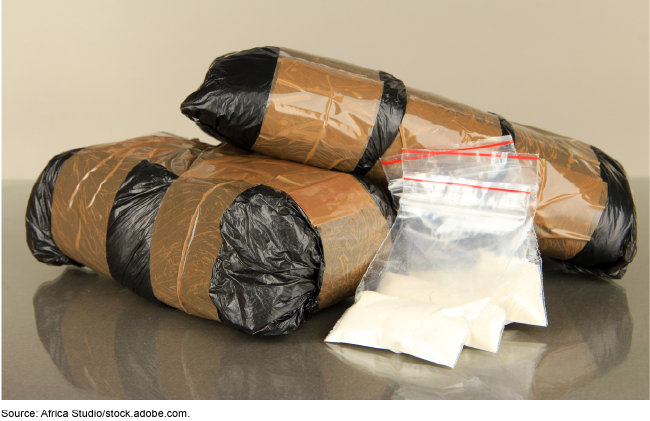Counternarcotics: DOD Should Improve Coordination and Assessment of Its Activities
Fast Facts
According to the U.S. government, illicit drugs and the criminal organizations that produce and traffic them are a significant threat. DOD leads federal efforts to monitor the air and water transport of drugs like cocaine and fentanyl into the U.S.
DOD set up a joint operation area including the western U.S. border and parts of Latin America. But 3 of DOD's regional components' areas of responsibility overlap this area, which causes confusion about who should manage which operations there.
Documenting responsibilities in an agreement could help as DOD works to disrupt drug trafficking.
Our recommendations address this, and more.

Highlights
What GAO Found
The amount of funding available for Department of Defense (DOD) counternarcotics and counter–transnational organized crime activities changed from about $750 million in fiscal year (FY) 2018 to about $580 million in FY 2022. In FY 2022, DOD allocated most of the funding to support detection and monitoring activities and allocated the remainder to support intelligence activities and efforts, such as constructing training facilities, in partner nations.
DOD's six geographic combatant commands—DOD components responsible for efforts in designated geographic areas—coordinate on activities. However, three reported varying understandings of their roles in an overlapping joint operation area, including confusion over the management of air and naval operations. Although DOD required the three commands to develop agreements defining their responsibilities, the three commands have not fully documented their roles in the overlapping joint operation area. Without such agreements, confusion about the commands' responsibilities in the area may continue, reducing DOD's ability to disrupt the transport of illicit drugs to the U.S.
Map Showing Overlap of Joint Operation Area

DOD has not assessed the agency-wide effectiveness of its counternarcotics and counter–transnational organized crime activities and does not have a plan for future assessments. DOD has defined its strategic objectives, strategies, and performance goals. But contrary to key practices, it has not identified measurable outcomes for each strategic objective. As a result, DOD cannot measure progress toward these objectives. Officials also said they intend to assess agency-wide progress but have not developed a plan to do so. Assessing agency-wide progress toward its strategic objectives would better position DOD to make decisions about priorities, resource allocations, and strategies for improvements.
Why GAO Did This Study
The U.S. government has identified illicit drugs, as well as the criminal organizations that produce and traffic them, as significant threats to both the U.S. and partner nations. DOD is the lead department responsible for detecting and monitoring the aerial and maritime transport of illicit drugs to the U.S.
Senate report 117-130 accompanying the FY 2023 National Defense Authorization Act contains a provision for GAO to examine issues related to counternarcotics and counter–transnational organized crime activities. This report examines (1) funding available for DOD's activities and funding allocation in FYs 2018 through 2022; (2) the extent to which DOD components coordinate activities; and (3) how DOD assessed the effectiveness of these activities, and the extent to which its future assessments align with key practices.
GAO reviewed DOD documents and data about its authorities, funding, and activities, including coordination and performance management. GAO also interviewed DOD officials, including officials at headquarters and combatant commands.
Recommendations
GAO is making four recommendations, including that DOD develops a plan to assess agency-wide progress. DOD partially agreed with all recommendations. GAO maintains that fully implementing them is necessary to improve DOD's coordination and assessment of activities.
Recommendations for Executive Action
| Agency Affected | Recommendation | Status |
|---|---|---|
| Department of Defense | The Secretary of Defense should ensure that the Deputy Assistant Secretary of Defense for Counternarcotics and Stabilization Policy updates standard operating procedures for the C2IE data system to specify the quality control measures that should be reviewed and to assign responsibility for verifying that the information is accurate and consistent across combatant commands. (Recommendation 1) |
Open
When we confirm what actions the agency has taken in response to this recommendation, we will provide updated information.
|
| Department of Defense | The Secretary of Defense should ensure that the Deputy Assistant Secretary of Defense for Counternarcotics and Stabilization Policy works with INDOPACOM, SOUTHCOM, and NORTHCOM to develop up-to-date agreements that clarify and define their and their task forces' respective roles and responsibilities in the overlapping operation area. (Recommendation 2) |
Open
When we confirm what actions the agency has taken in response to this recommendation, we will provide updated information.
|
| Department of Defense | The Secretary of Defense should ensure that the Deputy Assistant Secretary of Defense for Counternarcotics and Stabilization Policy identifies measurable outcomes for each of DOD's CN/CTOC strategic objectives that can be used to assess progress toward the objective. (Recommendation 3) |
Open
When we confirm what actions the agency has taken in response to this recommendation, we will provide updated information.
|
| Department of Defense | The Secretary of Defense should ensure that the Deputy Assistant Secretary of Defense for Counternarcotics and Stabilization Policy develops a plan to assess DOD-wide progress toward its CN/CTOC strategic objectives. (Recommendation 4) |
Open
When we confirm what actions the agency has taken in response to this recommendation, we will provide updated information.
|
